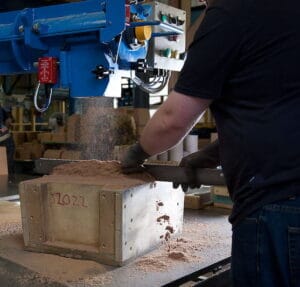In metal casting, our foundry engineers must consider a whole host of factors to ensure a high-quality, precision finished product. In this blog, we look at the most important elements in aluminium sand casting.
Preparing the mould

This is the first essential stage in the process. We use the highest quality sand, which is mixed with a binder and catalyst to add strength to the mould. This ensures the integrity of the mould during the casting process.
Preparation of the metal
Preparing the metal correctly is equally important to reduce the risk of any impurities or other issues. During the melting process, hydrogen gas can be introduced through external elements, such as moisture in the air, which can lead to gas porosity.
To combat this problem, the metal is put through a degassing unit where it is exposed to nitrogen. The nitrogen bonds with the hydrogen and this compound dissipates from the molten metal.
Pouring the metal
The metal pour is the next crucial step, and this must be managed very carefully to prevent casting issues and defects. The choice of alloy and the density of the required casting influence how the pouring is carried out. However, some general principles apply to this process.
If the pour is carried out too slowly, the molten metal will not reach all parts of the mould due to a lack of pressure and solidification.
However, if the metal is poured too quickly, turbulence can result, often leading to casting defects such as indentations.
Keeping the temperature at a constant level during the pour is also vital. The chemical and physical properties of the casting can be affected if the temperature is too hot but, if it is too low, the molten metal will not flow into all parts of the mould due to solidification.
Our experienced engineers use their skills to precisely judge the temperature and pouring rate required.
Running systems
The running system is at the heart of the casting process – much like the circulatory system in the human body. As we’ve discussed in previous blogs, a running system is a series of connected channels that allows the molten metal to flow and fill the mould cavity in aluminium sand casting. It enables us to control the liquid flow, turbulence, cooling rate and shrinkage.
Typically, the running system consists of a pouring cup, down sprue, runners, filters and risers, which ensure a constant supply of the liquid into the mould.
At Haworth Castings, we design a bespoke running system for each individual project – tailored to our customers’ individual requirements.
Finishing
This is the last stage in the casting process, which prepares the part for industrial use. The term ‘finishing’ covers a broad range of tasks, from fettling through to painting, alochroming, anodising and shot blasting.
Finishing is used to produce a specific surface finish, remove excess material, act as a pre-treatment for painting or simply to enhance the aesthetic qualities of the casting.
The level of finishing required is determined by the metal alloy and the end application.
So, in conclusion, the integrity of each individual casting is reliant on these elements being carried out correctly.
For more information on any aspect of our casting work, please call us today on +44 (0)1794 512685 or email us: [email protected].

